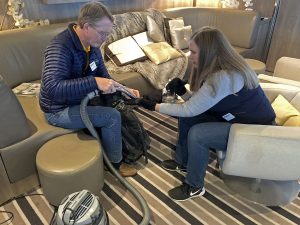A highlight of a trip to Antarctica is a visit to Port Lockroy, which is not only home to a colony of Gentoo penguins but also the headquarters for a British operation called the UK Antarctic Heritage Trust. One of the small buildings at Port Lockroy has a gift shop and a post office, where you can mail postcards and have them bear an actual Antarctica postmark. It’s called the Penguin Post Office—and if you don’t believe me, just read its more than 100 reviews on TripAdvisor.
(PBS did a Nature special on the Penguin Post Office in 2015. You can watch a short, fun trailer for it here.)
 We didn’t get to visit Port Lockroy, as it turns out—but we still got to mail postcards from there. Many of us had purchased postcards back in Ushuaia, and others bought them on the ship. The ship’s reception desk had the correct British Antarctic Territory stamps for sale (click on the image at left to see the stamps larger), and once we wrote the postcards and affixed the stamps, we returned them to the reception desk. Someone from the ship’s crew then took the postcards over to Port Lockroy for us on one of the ship’s Zodiac boats. We were told that the postcards first go to London, then on to their intended recipients—and will arrive in about two months.
We didn’t get to visit Port Lockroy, as it turns out—but we still got to mail postcards from there. Many of us had purchased postcards back in Ushuaia, and others bought them on the ship. The ship’s reception desk had the correct British Antarctic Territory stamps for sale (click on the image at left to see the stamps larger), and once we wrote the postcards and affixed the stamps, we returned them to the reception desk. Someone from the ship’s crew then took the postcards over to Port Lockroy for us on one of the ship’s Zodiac boats. We were told that the postcards first go to London, then on to their intended recipients—and will arrive in about two months.
Another attraction at the Penguin Post Office is that you can get your passport stamped there. Here again, we didn’t get to visit the post office, but we were told we’d get our passports stamped anyway. (Because of immigration formalities that I never fully understood, we had turned over our passports to the ship’s front desk at the beginning of the cruise and didn’t get them back until we disembarked.)
Some of us spent a little time speculating as to how, exactly, they were going to get all of our passports stamped at Port Lockroy. We had visions of them stuffing 200 travelers’ passports into a dry bag and taking them on a rubber Zodiac boat, powered only by an outboard motor, across icy Antarctic waters, in unpredictable weather, just to get a novelty stamp on each. What could possibly go wrong?
 I never did find out, but I’m guessing that when they dropped off the postcards to be mailed, they borrowed the passport stamp and brought it back to the ship, where some unlucky crew member spent an hour stamping each and every passport. Whatever the case, when we got our passports back at the end of the trip, sure enough, one of the pages in the back had a new stamp on it: Port Lockroy, Antarctica.
I never did find out, but I’m guessing that when they dropped off the postcards to be mailed, they borrowed the passport stamp and brought it back to the ship, where some unlucky crew member spent an hour stamping each and every passport. Whatever the case, when we got our passports back at the end of the trip, sure enough, one of the pages in the back had a new stamp on it: Port Lockroy, Antarctica.















